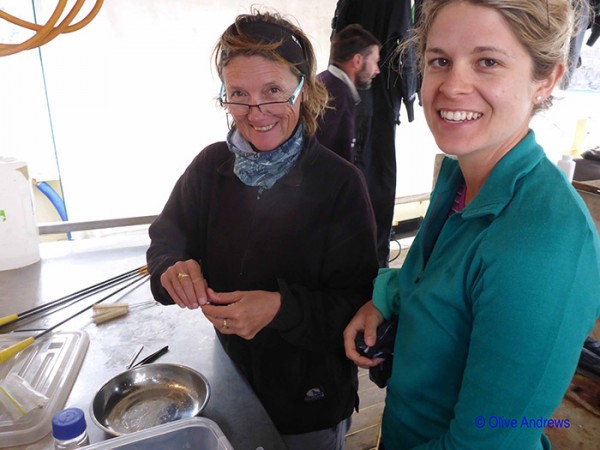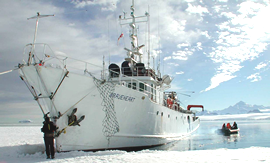Today we celebrate hump day as we reach the halfway point of our humpback study at Raoul Island. The last few days have presented us with some difficult weather, and Braveheart has shifted anchorages several times to tuck into the lee that shifts constantly around the island as the winds change. This has made things a bit tricky for our whale work as we pound through the swell in our two small boats. Nothing our team can’t handle, and most of us have enjoyed getting wet and salty. Whales have become scarce and flighty (we speculate that a ‘pulse’ of whales has departed Raoul for the Antarctic) but we are waiting patiently for the next migrants to arrive.

Braveheart has shifted anchorages several times as the winds change. Photo © Olive Andrews.
Our cetacean sharpshooters (Rochelle, Simon and Claire) have been busy tagging whales and collecting biopsies. We have now successfully deployed 14 satellite tags, and are quietly feeling pretty pleased with ourselves. As well as implanting tags and taking biopsy samples, the teams try to take photographs of the undersides of the whales’ flukes (their tails). This can only be done during the few seconds when the whales raise their flukes into the air just before taking a deep dive – requiring plenty of dexterity on the part of the boat drivers and photographers!

As well as implanting tags, the team has taken a number of biopsy samples. Photo © Olive Andrews.
The patterns on the flukes of humpbacks are caused both by natural colouration and by scarring (from attacks by killer whales, cookie-cutter sharks, barnacles etc). These marks are very distinctive and allow us to identify individual whales. Yesterday Olive was very excited after she successfully matched a fluke ID from one of our Kermadec whales to one seen during her annual humpback whale survey in Niue, recorded in July 2014. So now we know that at least one of these whales has come all the way from Niue to call past the Kermadecs on its journey south! Because this work has never been done at Raoul before we have no real idea of where these whales began their migration, but it is likely they come from a mixture of breeding grounds in the tropical Pacific.
In other news, Richie, Steve and James have been skiving off at lunchtimes to dive and snorkel the underwater paradise that surrounds Raoul. The rugby scores are being relayed to Braveheart by radio, and all on board are tired but happy.












